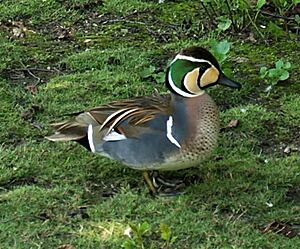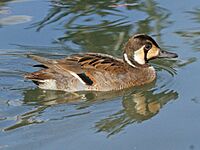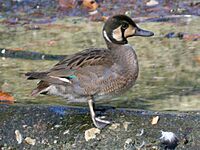Baikal teal facts for kids
Quick facts for kids Baikal teal |
|
|---|---|
 |
|
| A male at Cologne Zoo, Germany | |
| Conservation status | |
| Scientific classification | |
| Genus: |
Sibirionetta
|
| Species: |
formosa
|
 |
|
| Range of S. formosa Breeding Passage Non-breeding | |
| Synonyms | |
|
Anas formosa Georgi, 1775 |
|
The Baikal teal (Sibirionetta formosa) is a special type of dabbling duck. People also call it the bimaculate duck or squawk duck. These ducks spend their summers in eastern Russia. When winter comes, they fly to warmer places in East Asia.
Contents
What's in a Name?
A German scientist named Johann Gottlieb Georgi first described the Baikal teal. He did this in 1775. He gave it the scientific name Anas formosa.
Later, in 1929, another German scientist named Hans von Boetticher suggested a new group for this duck. This group was called Sibirionetta.
The name Sibirionetta comes from two words. Sibiricus is Latin for Siberia. Nētta is an old Greek word for a duck. The second part of its name, formosa, is Latin for "beautiful".
What Does It Look Like?
The Baikal teal is a medium-sized duck. It is a bit bigger than a common teal. These ducks are usually between 15 and 17 inches (39 to 43 cm) long. They weigh about 1 pound (0.45 kg).
Male Baikal Teals
Male Baikal teals are very easy to spot, especially during breeding season. They have a bright green patch on the back of their head. Their cheeks, neck, and throat are yellow and black.
They also have a dark cap on their head. Their chest is light brown with dark spots. Long, dark feathers hang down from their shoulders. Their sides are gray, with white stripes at the front and back.
Female Baikal Teals
Female Baikal teals look a bit like female green-winged teals. But female Baikal teals have a longer tail. They also have a clear white spot at the base of their bill. Their throat is white and goes back towards their eye.
They have a light eyebrow that stands out. A darker crown borders this eyebrow. The green part of their wing feathers has a light brown edge. Young male ducks sometimes look like females, but they might have some face markings.
Changing Feathers
When male ducks are not breeding, their feathers change. This is called eclipse plumage. During this time, they look more like females. However, their feathers are a richer reddish-brown color.
Where Do They Live?
Baikal teals breed in the forest areas of eastern Siberia. This includes places like the Yenisey basin and the Kamchatka Peninsula.
They are migratory birds. This means they fly long distances for winter. They spend their winters in warmer places like South Korea, Japan, Taiwan, and parts of China. They can be found along the coast from Beijing down to the Vietnam border. They also go west to Yunnan.
During breeding season, they live in ponds near the tundra edge. They also live in swampy forests. In winter, they prefer fresh water in low-lying areas.
How Are They Doing?
The Baikal teal is currently listed as a species of Least Concern by the IUCN Red List. This means their population is stable and not at high risk.
However, before 2011, they were listed as Vulnerable. This was because of hunting and the loss of their wetland homes in winter. Even though these threats still exist, the Baikal teal population is growing. More birds are being seen in their wintering areas. Their habitats are also increasing in some places.
Around 2010, scientists estimated there were about 1.07 million adult Baikal teals. This is a big increase from the 1980s, when only tens of thousands were counted. In the early 2000s, there were only a few hundred thousand. This shows a great recovery for these beautiful ducks!
Gallery





